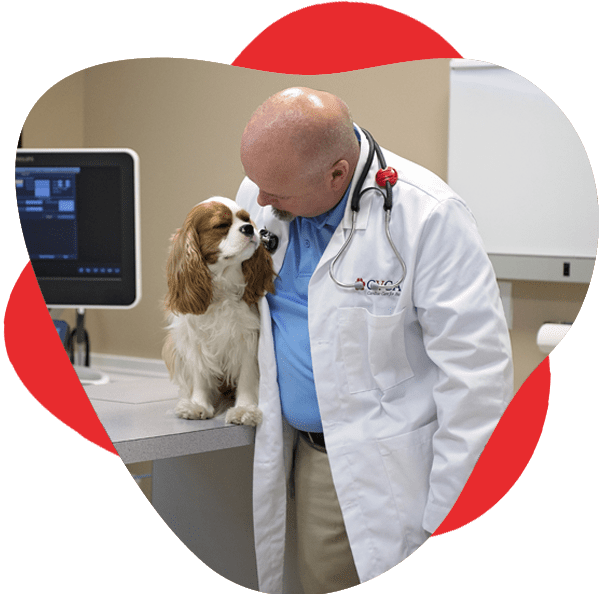What You Need to Find Out About Veterinary Solutions: A Review of Diagnostic Tools and Procedures
Veterinary solutions play a vital duty in maintaining the health and wellness of pet dogs. Regular check-ups can expose concealed wellness problems early on. Various diagnostic tools and procedures, such as blood tests and imaging techniques, offer necessary understandings right into a pet's health. Understanding these techniques is essential for pet proprietors. What certain diagnostic treatments are most frequently used, and just how can they affect an animal's treatment strategy?
Significance of Regular Veterinary Check-Ups
While lots of animal proprietors may take too lightly the relevance of regular veterinary exams, these visits are important for maintaining a pet's total health. Routine visits to the vet enable very early detection of possible wellness concerns before they intensify right into major troubles. Regular examinations often consist of inoculations, which are essential for protecting against infectious conditions that might significantly influence an animal's wellness. In addition, these appointments offer a chance for vets to assess the animal's weight, oral wellness, and overall condition, guaranteeing that the family pet is thriving. During these check outs, family pet proprietors can additionally receive important recommendations on diet regimen, workout, and preventive care tailored to their specific animal's requirements.
Typical Analysis Treatments in Vet Medication
In vet medicine, precise medical diagnosis is essential for effective treatment. Typical analysis procedures include blood testing methods, advanced imaging innovations, and urinalysis, each playing a considerable function in determining health issues. Understanding these approaches boosts the capacity to supply proper look after animal patients.
Blood Examining Strategies
Blood testing techniques function as crucial analysis tools in veterinary medication, allowing vets to evaluate the health of animals precisely. These methods involve accumulating blood samples to examine various parts, such as white and red blood cells, platelets, and biochemical markers. Typical tests consist of full blood counts (CBC), which evaluate general health and identify infections, and biochemical panels, which examine organ feature and metabolic status. Furthermore, serological tests can recognize particular conditions with antibody detection. Blood screening is minimally invasive and gives important information that aids in identifying conditions, keeping track of health and wellness standing, and evaluating responses to treatments. Generally, these techniques play an important duty in making certain suitable care for animals and animals alike.
Imaging Technologies Used
Analysis imaging modern technologies are important devices in veterinary medication, enhancing blood testing strategies by giving visual insights into a pet's inner structures. Usual imaging methods include X-rays, which are valuable for examining bone cracks and identifying foreign things, and ultrasound, which enables real-time visualization of soft tissues and organs. Magnetic vibration imaging (MRI) uses detailed pictures of complicated anatomical locations, particularly in neurological assessments. Calculated tomography (CT) provides cross-sectional photos, improving diagnostic accuracy for numerous problems. Each of these modern technologies aids vets in identifying illnesses, intending treatments, and checking recovery. By integrating imaging modern technologies, veterinary professionals can better examine a pet's wellness and make educated decisions regarding their treatment.
Urinalysis and Diagnostics
Urinalysis works as a vital diagnostic tool in vet medicine, giving useful understandings into an animal's overall health and assisting in the detection of numerous conditions. This non-invasive treatment analyzes pee samples to assess kidney function, hydration condition, and metabolic disorders. Typical elements examined consist of particular gravity, pH levels, sugar, proteins, and the presence of blood or microorganisms. Uncommon searchings for can indicate problems such as urinary system infections, diabetic issues mellitus, or kidney disease. To improve diagnostic accuracy, urinalysis is frequently done in conjunction with various other tests, such as blood job and imaging researches. Early discovery via urinalysis can result in prompt interventions, improving the diagnosis for several vet patients. For that reason, it is a crucial aspect of thorough vet treatment.
Understanding Blood Tests and Lab Analysis
Recognizing blood examinations and lab analysis is essential in vet medicine as it aids in diagnosing different health and wellness problems in animals. Various sorts of blood examinations supply vital information regarding an animal's interior state, while interpreting laboratory results requires mindful consideration of countless elements. This section will certainly check out the types of blood examinations offered and the value of their outcomes.
Kinds Of Blood Examinations
Blood examinations play an important role in vet medicine, supplying important insights right into an animal's health and wellness status. Numerous sorts of blood tests are made use of, each offering different functions. Full blood matters (CBC) examine total wellness and identify conditions such as anemia or infection. Biochemical accounts assess organ function by determining electrolytes and enzymes, using understandings into metabolic health and wellness. Serological tests recognize certain antibodies or microorganisms, helping in the diagnosis of infections or autoimmune illness. Blood keying guarantees safe transfusions, while coagulation tests evaluate the blood's capacity to embolisms, essential for operations. These examinations collectively enhance medical diagnosis, therapy preparation, and surveillance of an animal's health and wellness, showing the value of complete laboratory evaluation in veterinary treatment.

Analyzing Laboratory Results
A complete evaluation of laboratory outcomes is necessary for exact diagnosis and treatment in vet medication. Translating lab results calls for an understanding of regular recommendation ranges and the significance of inconsistencies. Blood examinations can reveal numerous health and wellness signs, such as organ feature, electrolyte balance, and the presence of infections. Vets need to think about the whole scientific picture, consisting of the animal's background, checkup findings, and any kind of signs offered. Variations in outcomes may emerge from aspects such as age, type, and underlying health and wellness conditions. As a result, lab results should not be checked out in isolation however rather as part of an all-encompassing analysis approach. Precise analysis enables tailored therapy strategies and better results for vet patients.
Imaging Techniques: X-rays, Ultrasounds, and Beyond
Imaging methods are essential tools in vet medication, providing vital understandings right into the health and well-being of animals. Among one of the most commonly made use of approaches are Ultrasounds and x-rays. X-rays are important for picturing bone frameworks, aiding vets identify fractures, tumors, or foreign objects. This technique is non-invasive and quick, making it suitable for immediate situations.Ultrasounds, on the various other hand, make use of audio waves to develop photos of soft cells and body organs. This strategy is specifically useful for taking a look at the heart, abdomen, and reproductive organs, enabling veterinarians to evaluate conditions like fluid buildup or organ abnormalities.Beyond X-rays and ultrasounds, progressed imaging strategies such as computed tomography (CT) and magnetic vibration imaging (MRI) are significantly used in vet method. These techniques provide comprehensive cross-sectional images, enhancing the precision of medical diagnoses and treatment plans. Ultrasound For Dogs. Overall, imaging strategies play a crucial function in guaranteeing effective vet care
The Role of Biopsies in Diagnosing Pet Dog Wellness Issues
Precision in detecting wellness problems in pets often pivots on making use of biopsies, More Help which provide clear-cut info regarding cells irregularities. A biopsy involves the elimination of a small sample of cells for evaluation under a microscopic lense, enabling vets to identify numerous conditions, consisting of infections, tumors, and inflammatory illness. This analysis tool is crucial for differentiating between benign and deadly growths, leading treatment choices, and evaluating the severity of a condition.Biopsies can be done making use of various methods, such as needle goal, incisional biopsies, or excisional biopsies, depending upon the place and kind of tissue included. The option of technique might affect recuperation time and the amount of cells accumulated. Ultimately, the info amassed from a biopsy can lead to targeted therapies, boosting end results for animals dealing with significant health difficulties. Vets stress the importance of this procedure in accomplishing precise medical diagnoses and reliable therapy strategies.
Advanced Diagnostic Devices: Endoscopy and CT Checks

Advanced diagnostic tools, such as endoscopy and CT scans, play an important duty in modern-day vet medicine, offering non-invasive methods to envision interior frameworks and identify various problems in family pets. Endoscopy includes the use of a flexible tube equipped with a camera, permitting veterinarians to examine the gastrointestinal system and respiratory system straight. This method can reveal problems such as growths, international bodies, or swelling, enabling targeted therapy plans.CT scans, on the other hand, make use of sophisticated imaging technology to develop comprehensive cross-sectional photos of the body (Board Certified Veterinary Cardiologist). This technique is specifically beneficial for evaluating complicated structures like the brain, back, and joints. By offering high-resolution photos, CT scans assist vets in recognizing problems that might not be obvious via conventional radiography. With each other, these advanced tools improve analysis accuracy, enhance therapy outcomes, and ultimately add to far better overall family pet wellness management

Translating Examination Results: What Pet Owners Need To Know
Comprehending examination results can be a tough task for pet owners, especially after advanced treatments like endoscopy and CT scans have been see here done. Interpreting these outcomes requires a grasp of clinical terms and a clear understanding of what the findings show about the family pet's wellness. Veterinarians commonly supply descriptions, but the intricacy of the results can still cause confusion.Pet proprietors need to actively participate in conversations with their vets, asking questions to clear up any unpredictabilities. It is necessary to comprehend abnormal versus typical outcomes and the ramifications for the animal's treatment plan. Furthermore, acknowledging that some outcomes might call for further testing or monitoring can help owners stay notified concerning their pet dog's health journey. Eventually, a collective approach between pet dog owners and vet experts promotes much better health and wellness results and boosts the total treatment experience for family pets.
Regularly Asked Inquiries
Just how Do I Pick the Right Vet Center for My Animal?
Selecting the best veterinary clinic involves researching neighborhood alternatives, reviewing credentials, checking out centers, and evaluating staff interactions (CT Scans For Animals). Focusing on suggestions from trusted resources can assist guarantee the ideal treatment and atmosphere for a pet dog's wellness demands
What Should I Do if My Family Pet Declines to head to the Veterinarian?
When an animal refuses to head to the vet, it's advisable to continue to be calm, usage deals with or toys to tempt them, and think about scheduling a home browse through if stress and anxiety persists. Perseverance and positive support are essential.
Exist Telehealth Options for Veterinary Providers?
Telehealth alternatives for vet services are increasingly available, allowing pet proprietors to speak with veterinarians remotely. These solutions allow discussions concerning wellness issues, guidance on small conditions, and follow-ups without needing to see a center.
How Often Should My Pet Dog Have Dental Check-Ups?
The regularity of dental exams for animals commonly depends upon their age and type. Typically, veterinarians advise annual oral assessments, although some pet dogs may call for more constant sees to preserve ideal dental health.

What Are the Prices Related To Vet Diagnostics?
The prices related to vet diagnostics can differ commonly, typically varying from fundamental tests like blood work to innovative imaging methods. Elements affecting costs include the facility's place, tools utilized, and particular examinations required for each family pet. Veterinary solutions play an essential duty in preserving the health of pets. While several pet owners might ignore the significance of normal veterinary exams, these consultations are necessary for maintaining a pet's overall health and wellness. Additionally, these visits provide an opportunity for veterinarians to analyze the animal's weight, oral wellness, and total condition, making certain that the pet Get the facts is thriving. Precision in identifying wellness issues in family pets often hinges on the use of biopsies, which give definitive info concerning tissue problems. In addition, recognizing that some results may require additional screening or surveillance can help owners stay notified regarding their pet dog's wellness trip.